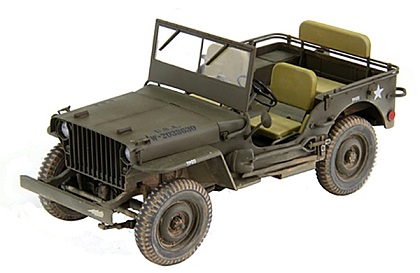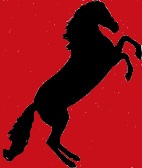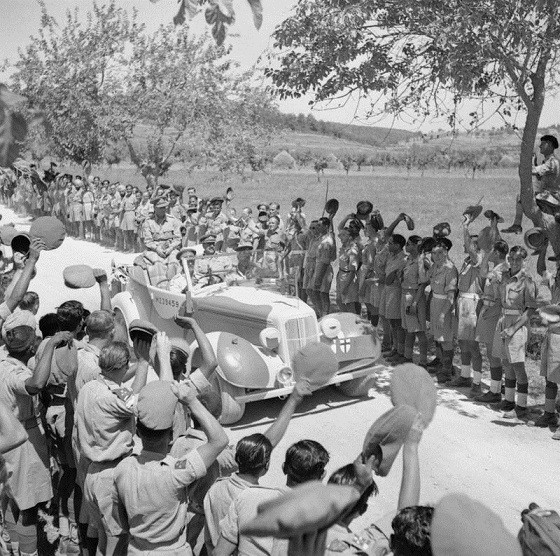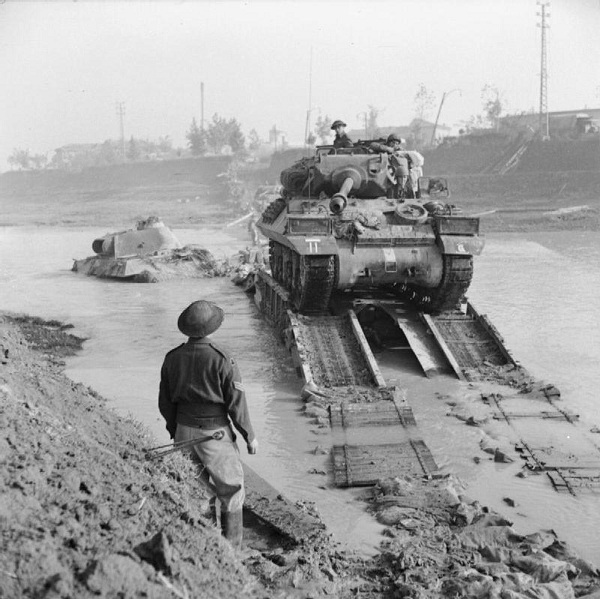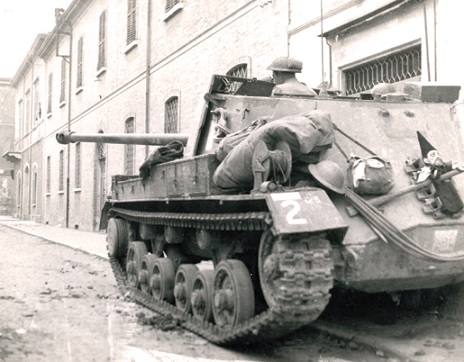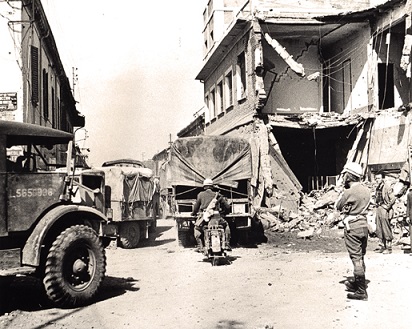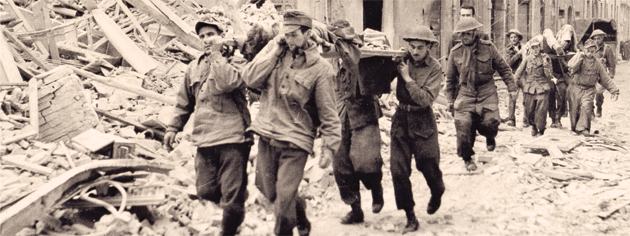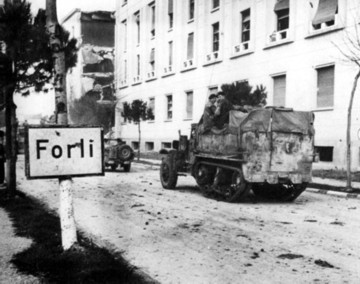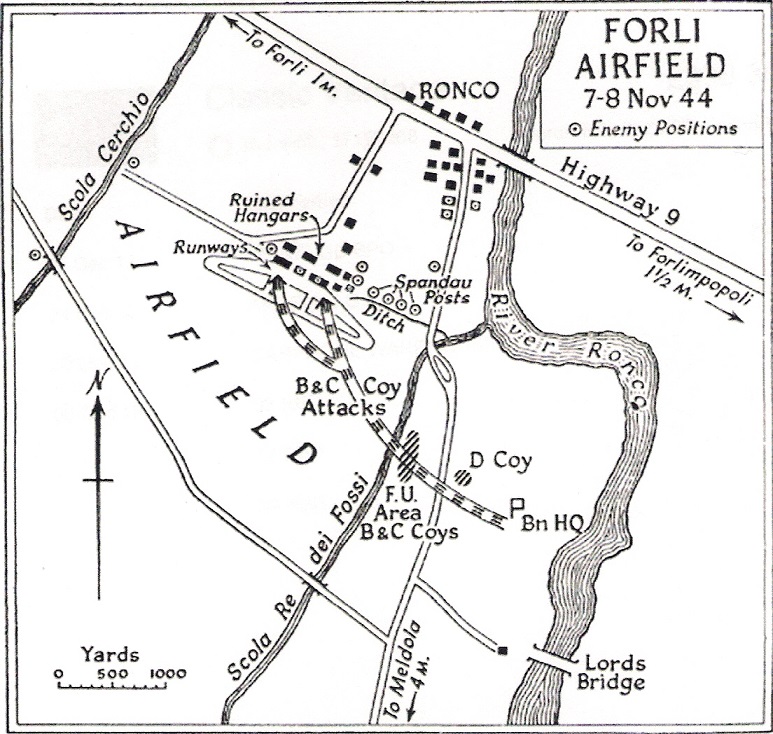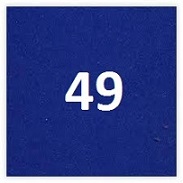The Shiny Seven in the Italian Campaign 1944 Part Two The Gothic Line
The geography and topography of the route and locations where the Shiny 7 fought, trained and rested in the Italian Campaign 1944
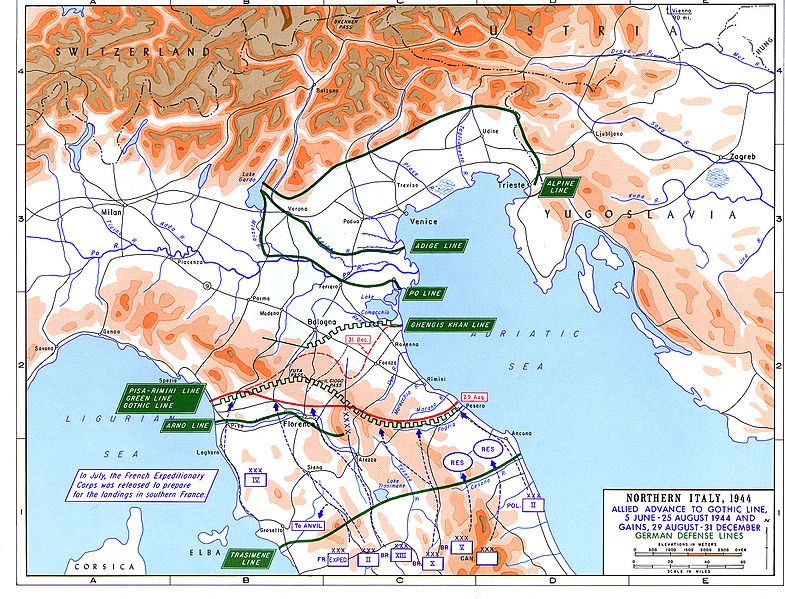
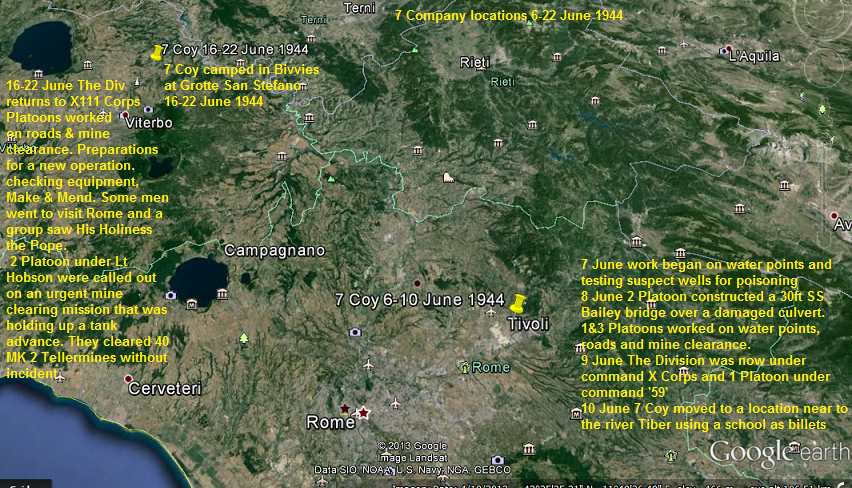
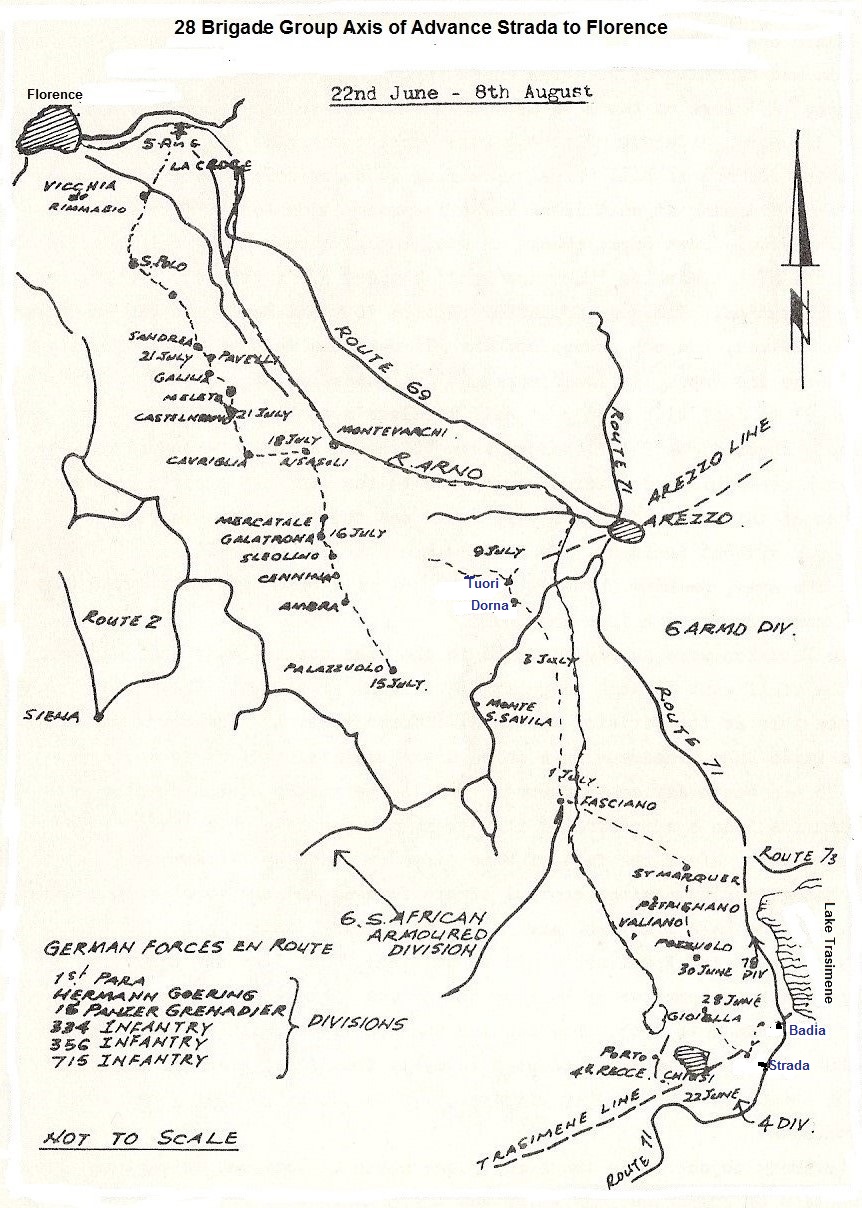
23 June. The Coy took over a location vacated by 256 Fd Coy at Citta d Pieve. Platoons were out working on culverts and a water point. At this time the Company officers were:
OC Major A.D.D. Dawson
Second in Command Captain C.G. Hodgart, Recce Lt B.M. Roberts & Lt P.D Smart
1 Platoon Lt A. Hobson MC
2 Platoon Lt A.L.S. Bocker
3 Platoon Lt M.N. Sharland
2 platoon sent a section to support 2 SLI & 2 Kings. 3 Platoon were in support of 2/4 Hants. A steady trickle of casualties from the Rapido Operations were welcomed back, and a number of reinforcements brought the strength up to something like normal. Morale was very high in the Company as they prepared for the next day.
24 June Saturday. The Sections made an early start to join the Infantry in their attack on 1 Para German Div. From Strada to Badia near Lake Trasimene.
25 June. 2 & 3 Platoons cleared wrecked vehicles, a tank and lifted mines from the roads and verges. At 2100 hours the OC and Lt Roberts were seriously wounded when their Dingo scout car blew up by an A/T mine. They were evacuated and eventually returned to the UK. 3 Platoon cleared the track after this happened. The battle of Trasimene continued with heavy fighting for the next five days when the 7th in support of the 28 Bde dealt with craters and opened up communications. Whilst taking food up to 2 Platoon Dvr P Maughan was wounded in the chest and evacuated. The enemy began to use the few aircraft at his disposal at night machine gunning forward troops and dropping canisters of ‘Butterfly’ bombs. In one attack 2 Platoon in their slit trenches for the night were attacked in moonlight. The aircraft had a look and then attacked. Tracers could be seen hitting the ground across the Platoon slits but no one was hit.
This map illustrates the Northern lines of the German defences. The Gothic line was the main line, 12000 slave labourers were put to work building it. However, Hitler was still concerned on it's strength and told Kesselring to change the name. Kesselring renamed it the Green Line
L-R Lts P Smart, C Blewett, L Bocker
The above photos were taken in 1943
Dvr P Maughan
On the 25 June 1944 he was
wounded in the chest and later evacuated
L/Sgt Stamper
Sprs Williams and another
1 July. Major J.H. Bond MC became OC in place of Major Dawson. A running battle now ensued as the enemy pulled back to the Arrezo line on which he was determined to stand as long as possible. 8th Army needed this base as quickly as possible to build up for the assault on the 'Gothic Line' before the winter rains came. Air photographs were used extensively, they were issued from HQRE then assembled at '7's HQ giving a picture of the work to be done on the 28 Bde axis of advance for which the 'Shiny 7' were responsible.
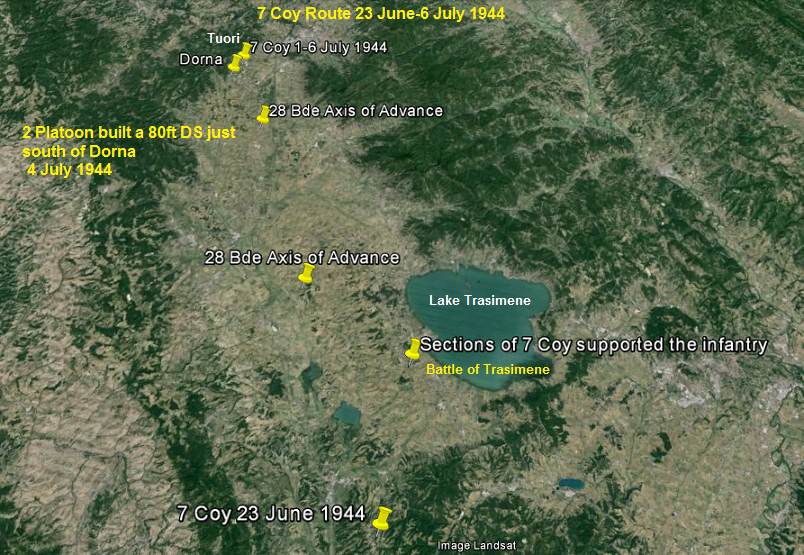
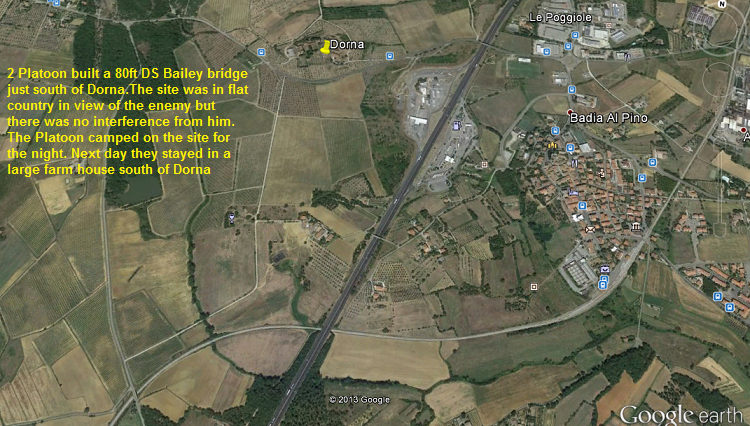
4 July. 2 Platoon built a 80ft DS Bailey bridge on 28 Bde main Axis of advance in open flat country south of Dorna. It was in view of the enemy but there was no interference. The platoon camped on site and moved off toward Dorna in the dark before dawn.
An officer and 30 ORs were attached from 91 Light AA Regt RA to assist with Sapper work.
5 July. At Dorna a sentry advised them to turn around as he was a forward lookout on point duty. The Platoon turned around and moved into a large farm. A recce party in the 'Amazon Jeep', drove as far as possible across country towards Tuori to 2 Kings FDLS, none could be found. (the Amazon Jeep was the Jeep found abandoned near the Amazon bridge site. The Company found it enroute to collect Major Low who was wounded and it was used to take him to the ADS. The 7th held onto this Jeep for many weeks) The local population of Tuori fled down the slopes shouting 'Tedeshi' and in came the familiar stonk. It was decided that the platoon would move forward to Dorna then on foot to fill a number of craters on the road to Tuori under observation by the enemy. A bulldozer was used at a crossroads near Dorna . The work was completed without incident.
6 July. Soon after midnight (5/6 July) 3 Platoon went forward to Tuori in support of an attack by 2 SLI who were trying to relieve 2 Kings. The platoon were pinned down by observed shell and mortar fire. Lt Sharland ordered a recce party to return, and check the road on a bend at the bottom of a hill leading up to Tuori from Dorna. L/Sgt Lampert with Sprs Thomas and Wilde moved off, and after being heavily stonked took cover in a house, where Spr Wilde was killed by a shell burst on the top of a wall above an outhouse.
LCpl James made a number of journeys to the Platoon who were trapped. Their wireless set was knocked out, and Sgt F Clark DCM was wounded in the arm and evacuated.
7 July. Lcpl James was immediately awarded the MM for his actions at Tuori
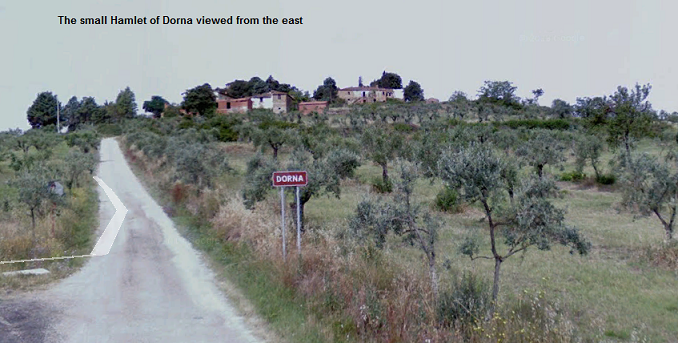
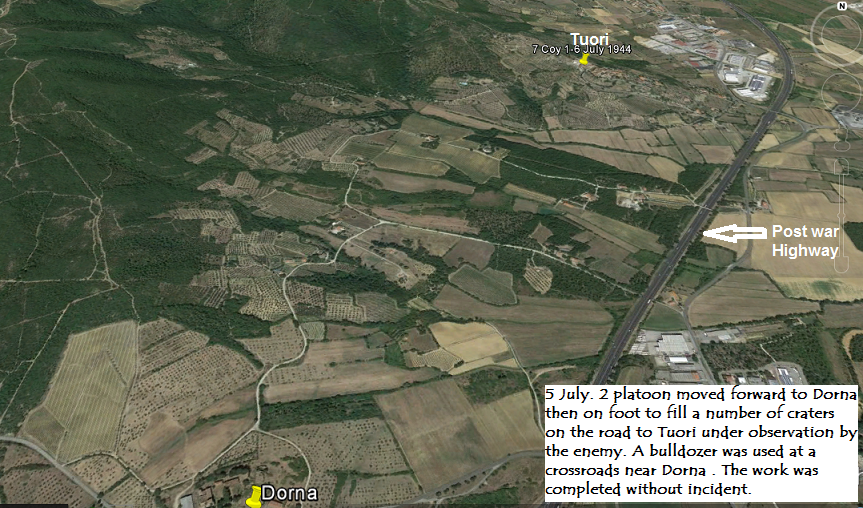
Left & below. The 7th advanced on Tuori from Dorna taking a NW route into mountainous broken country overlooked by the surrounding heights of the mountain range across the front-north towards Arrezo. 2 Kings were halted and heavily stonked by artillery. All roads, crossroads, culverts, were cratered, and bridges blown.
The bridge was built on the main axis
7 July Friday. 3 Platoon were able to withdraw at 0130 hours, less one jeep and '21' set destroyed . The battle for Arrezo continued for ten days until 16 July.In the meantime work continued at pace. Movement in daylight was slow due to dust clouds into which the enemy guns crashed down stonks.
16 July Sunday. At 0400 hrs the 28 Bde Group advanced, and made a side stepping movement to the west and left of the Divisional front taking over from the 12 South African Motor Bde of 6 South African Armoured Div. The 28 Bde axis was now, Ceninia, San Leolino, Galatrona, Mercatale, Riscasoli Hill, overlooking Montevarchi. Riscasoli was known as the ‘Imragard Line’. The enemy had prepared a number of positions known by girl’s names in alphabetical order, and north to Florence: they were, Imragard, Karin, Lydia, Maedchen, Olga and Paula. The Sappers were looking forward to “Paula”.
Wireless set No 21
During the Italian Campaign Platoons/Sections were often detached from the Company supporting units in 4 Division
17 July Monday. 2 Platoon supported by a party from 91 Lt AA Regt RA took the lead. The roads were a mass of rubble, and 3 Platoon followed up building a 40' SS. The next day 1 Pl built a similar bridge. Mine clearance, diversions and water points were the order of the day.
19 July. At 0200 hrs after doing a job at Mercatale Lt Sharland was mortally wounded in the head. After supervising the work of a bulldozer driven by Spr R Cherry (18 Fd Pk) his recce party were leading the bulldozer back with dimmed lights. Suddenly Lt Sharland, sat in the passenger seat fell sideways over the steering wheel.The vehicle went into a ditch. Cpl Williams sat him up. The only wound visible was a small hole in his head. He was taken to the ADS by a stretcher jeep where he later died. Lt Sharland wrote several poems during the campaign.
20 July. 2 Pl took up the lead on the Montevarchi - Cavriglia road supporting 2/4 Hants. While 8 Section was filling in craters the enemy kept up an almost continuous stonk. 3 Pl were unable to use a D4 bulldozer due to the stonking.
21 July. The 7th had three Sherdozers attached as from 2000 hrs, These were Sherman tanks fitted with a blade. Some had their turrets removed.
A Platoon from the '225' were attached, and built a 50' SS apart from other road clearing jobs.
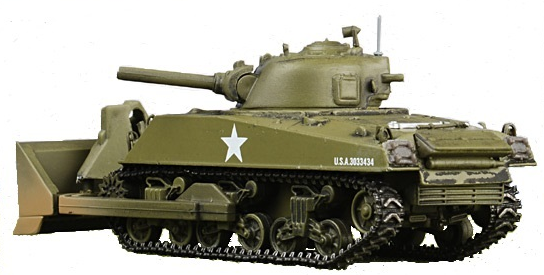
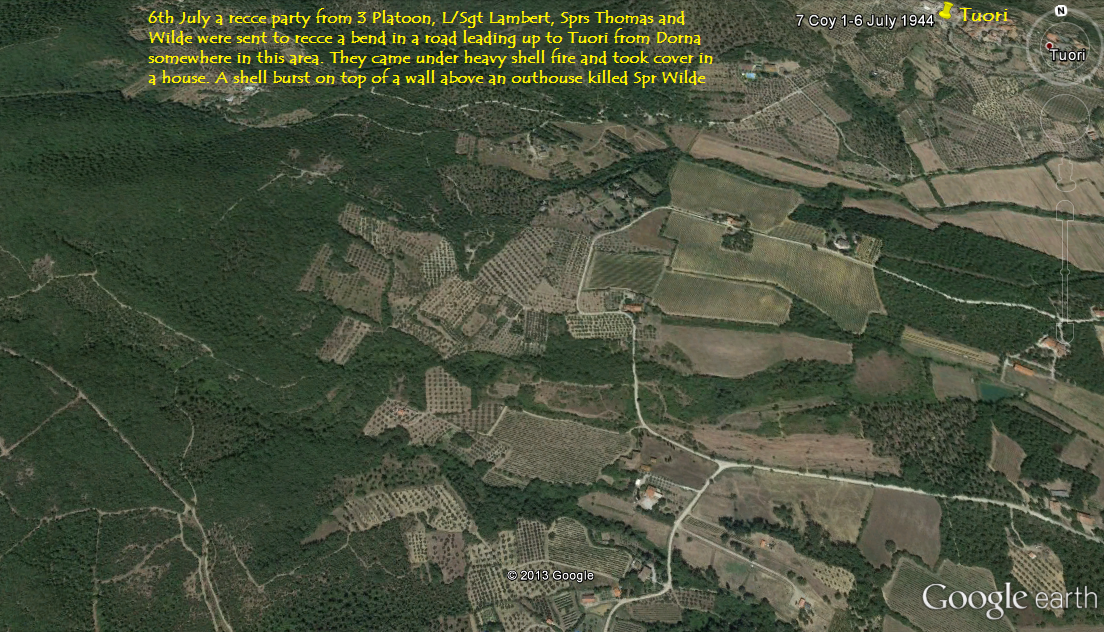
The Company received three Sherdozers on 21 July
22 July. Lt Barnes returned after a spell in hospital. He and Lt Smart were constantly doing forward recces, slowed down at times by small arms fire. The Canadian tanks supporting the Division were transferred to 8th Indian DIV, and replaced by 25 Army Tank Bde, equipped with Churchill tanks (class 40), and the North Irish Horse were in support of 28 Bde.
24 July. 2 Pl built a 50ft SS at Cavriglia, dispensing with jacks, using transoms as levers to remove the rollers and fit end posts and lower the bridge on to its bearings. They also built a 10' SS one bay BB.
26 July. The 2/4 Hants paraded for King George VI to decorate Captain Wakeford, (4 DIV) and Fusilier Jefferson 2 LF, (78 DIV) with the VC for actions at Cassino. All units of 4 Division provided detachments to line the route for the King.
HM King George VI decorates Captain Wakeford VC (left) and Fusilier Jefferson VC. Italy 26 July 1944
Allied soldiers line the route to welcome HM King George VI on his way to the investiture of the Victoria Cross winners and the Knighting of Lieutenant General Sir Oliver Leese 26 July 1944
At a different location HM King George VI decorates Sepoy Kamal Ram VC 8th Punjab Regiment British Indian Army 26 July 1944
All three recipients of the Victoria Cross were for their actions on the fourth battle of Monte Cassino
2/4 Hants on parade for the Victoria Cross investiture of Capt Wakeford and Fusilier Jefferson
26 July 1944
27 July. 28 Bde were through the ’Karin’ Line and were advancing toward Gaville. Frequent patrols were made with the infantry and some patrols included Partisans. One of the few prisoners taken by the 7th in Italy was captured by Cpl Ralph north of Meleto, whilst searching for the Platoon who had disappeared into the blue.
28 July -7 August.. 2 Pl using two Sections and forty ORs of the attached RNF built an 80ft DS on the road from Gaville to Pavelli opening the road to this village. The enemy stonked away with ‘Moaning Minnies’ causing one RNF casualty who was evacuated. The bridge was called ‘Northumberland Bridge’, named after the Royal Northumberland Fusiliers who helped to build it. 28 Bde closed on the River Arno near Florence breaking through the ‘Lydia’ Line in the process. Spr Montgomery of 2 Pl was wound in the foot and was evacuated. Whilst moving down to the river line from the last ridge on the nearside of the Arno, the vehicle carrying a Section of 91 Lt AA Regt RA, received a direct hit, the whole Section was either killed or wounded. The vehicle was a ‘Write Off’. Dvr Portsmouth was evacuated. Tanks were moving on same route and they always attracted maximum attention from the enemy.
8 August Tuesday. The Division’s task was completed. ‘Paula’ had fallen. 1 Division took over. Platoons withdrew in pouring rain during the evening to 7th HQ. The enemy declared Florence an ’open city’ destroying all the bridges over the River Arno except the Ponte Vecchio. Buildings on the approaches were demolished effectively blocking it.
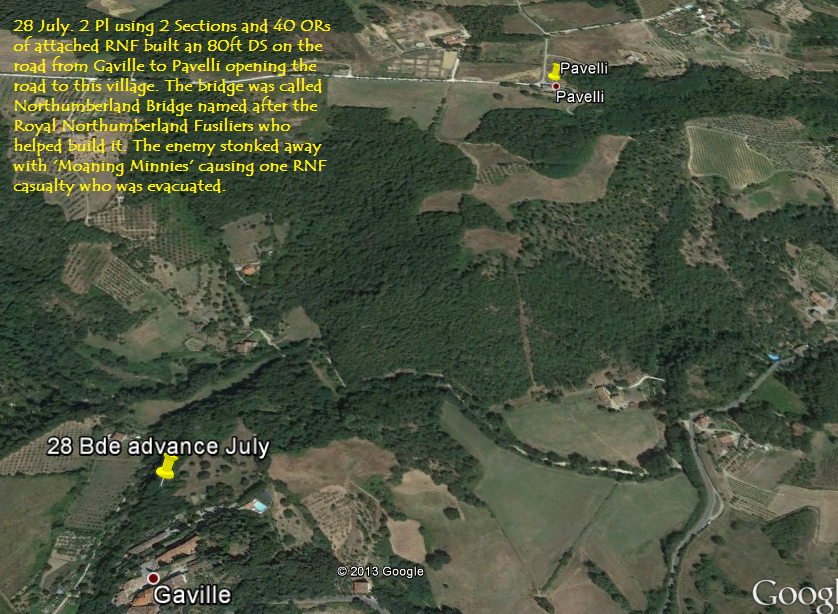
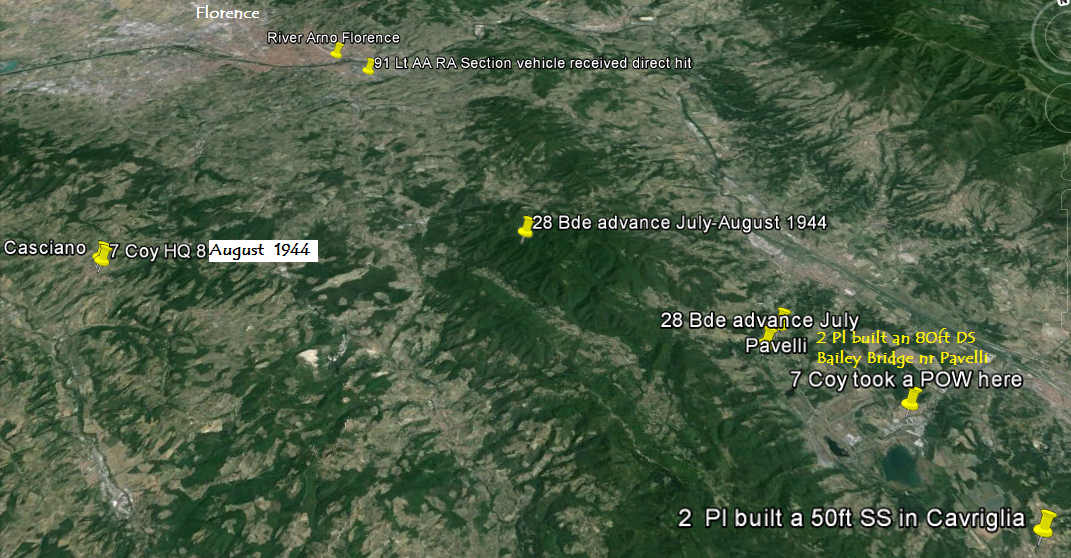
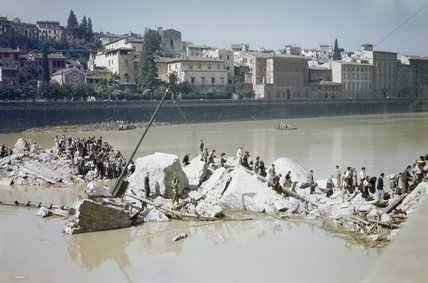
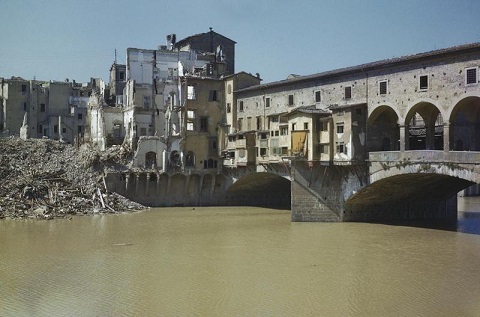
Ponte Vecchio, the only bridge the Germans didn't destroy in Florence, though they destroyed buildings either side to block it
Ponte Alle Grazie,
one of the five bridges the retreating Germans destroyed
over the River Arno.
Civilians clamber over the ruins to cross the river August 1944
Capt Wakeford VC of the 2/4 Hants
was the only VC awarded in 4 Division in WW2
9 August.The Shiny 7 set off from Casciano at dawn en-route to a location near Foligno, taking route 69 south and then taking route 71 travelling toward the northern shore of Lake Trasimene - Perugia - Assisi then to a quiet location near Foligno. A journey of 180 miles. The Company arrived at 1600 hours and quickly set up camp. This would be the Company location for the next three weeks. Here they would rest, sleep, eat regular food, sport and recreation, concerts, visits to Castel Gandolfo (near Rome) and Lake Trasimene rest camps. They would also prepare for the next operation, training and checking all equipment, stores, ammunition, vehicles etc.
13 August. A voluntary church parade was attended by the whole unit in the open.
16 August. 2 Pl went on detachment to lake Piediluco, the place chosen as a permenant Divisional Rest Camp, situated on the side of a lake. The Platoon camped on the lake side someway from the Rest Camp, and opposite Piediluco on the other side of the lake. The work was a good change, erecting German sectional timber huts and general plumbing work in the main building.
27 August. Lt-General Sir Oliver Leese attended a Divisional church parade in the stadium at Foligno, and fifty all ranks represented the 7th under command of 28 Bde. The service was taken by The Lord Bishop of Litchfield. Part of the Divisional service sheet includes the Divisional Prayer.
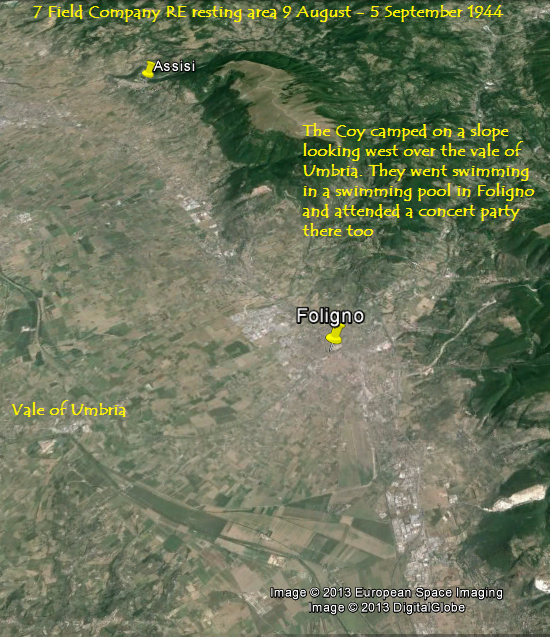
28 August. Spr L Kearnes, 2 Pl was drowned in Piediluco Lake during the evening whilst returning from the village. Each evening one of the locals ferried a party across the lake to Piediluco from the Platoon camp. On the way back shortly after leaving the shore the boat capsized, all of the party except Spr Kearns managed to regain the shore, and reported as soon as possible to the platoon, by which time it was almost dark. Despite every effort that night and the next morning from first light, his body could not be found. Eventually the body surfaced and 6 Section, 2 Pl who were still at Piediluco on detachment, made a coffin and buried him in a local cemetery. Some time later he was moved to the War Graves Commission cemetery at Assisi.
The Address
HYMN FOR OUR COMRADES IN ARMS
O Trinity of Love and Power.
Our brethren shield in danger's hour.
From rock and tempest fire and foe.
Protect them where so ever they go.
Thus evermore rise to Thee.
Glad hymns of praise from land and sea.
Let us pray
THE DIVISIONAL PRAYER
O Lord God, when Thou givest to Thy servants to endeavour
any great matter, grant us also to know that
it is not the beginning, but the continuing of the same until
it be thoroughly finished, which yieldeth
the true glory, through Him that for the finishing of Thy work
laid down His life, even Thy son.
Our Redeemer Jesus Christ. Amen
THE BLESSING
NATIONAL ANTHEM
2 Platoon location near 4 Div Rest Camp, Piediluco.
Spr Kearns was drowned using this type of craft
whilst crossing the lake 28 August 1944
Photograph T M J Riordan
27 August. A Section was detached to 59 Company to help with a major and difficult task, a part demolished viaduct over a deep gorge on the Pergola by-pass. The plan was to bridge the demolished spans onto the intact central span. It was decided to work from both ends of the viaduct and meet up on the central span. It required four separate bridges: a 30ft single girder, an 80ft double girder, a 90ft triple girder, and a 40ft single girder bridge. A total of 240ft run of Bailey equipment. There was another snag though, before they could get to the northern end they needed to bridge a demolished culvert. This required a 50ft single girder bridge. The Bailey bridging was held and supplied by 18 Field Park Company RE. The 59th were grateful for the help from 7 Coy who built one of the bridge sections. It was a good job done and greatly eased the traffic flow to forward units.
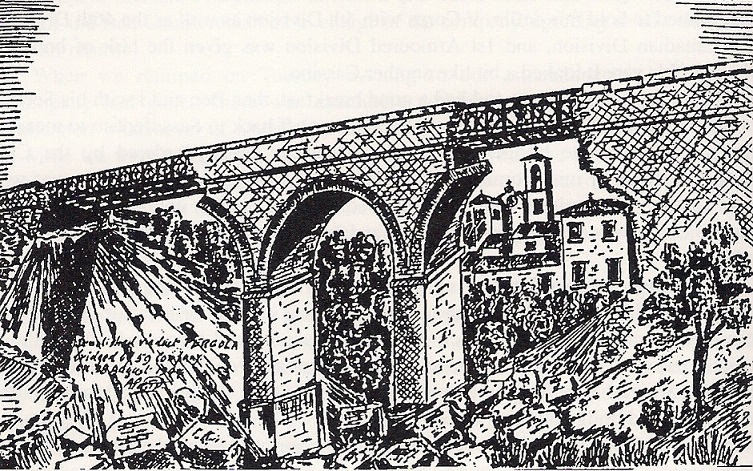
5 September. The Division was ordered forward. They would come under command of 1 Canadian Corps from September 7th, and their task would be to assault in the area of Coriano. At 2300 hrs the rest cure was over, and they moved forward in Inky blackness via Foligno - Fabriano - Sassoferrata, arriving at Sengallia in time for breakfast the next morning at 0730 hrs in an open field.
7 September. At 0030 hours I Canadian Corps issued a warning order to move at 2300 hrs. In the afternoon there was widespread thunderstorms, and by the evening roads were becoming impassable by deep mud. At 2330 hrs Shiny 7 bright as a button were on their way. At 2339 hrs all traffic came to a standstill at the side of the road where they stood due to roads washed away and culverts destroyed.
8 September. Weather conditions split the 7th's convoy. The move via route 16, Fano Pesaro had all the signs of the recent battle with wrecked vehicles, tanks, and equipment. Finally at 1430 hrs the head of the convoy arrived at La Tombaccia halting in a large field. Vehicles dispersed around the field and bivvies were set up making camp.
9 September. The tail of the convoy turned up after a muddy, stop start journey. Water points were recced in 28 Bde area, which was an immediate task whenever the Bde moved to a new location.
14 September. A short move was made at 1700 hrs to San Giovanni a small village. 'A' Echelon remained at La Tombaccia. The rumble of the guns indicated that the battle was not far away.
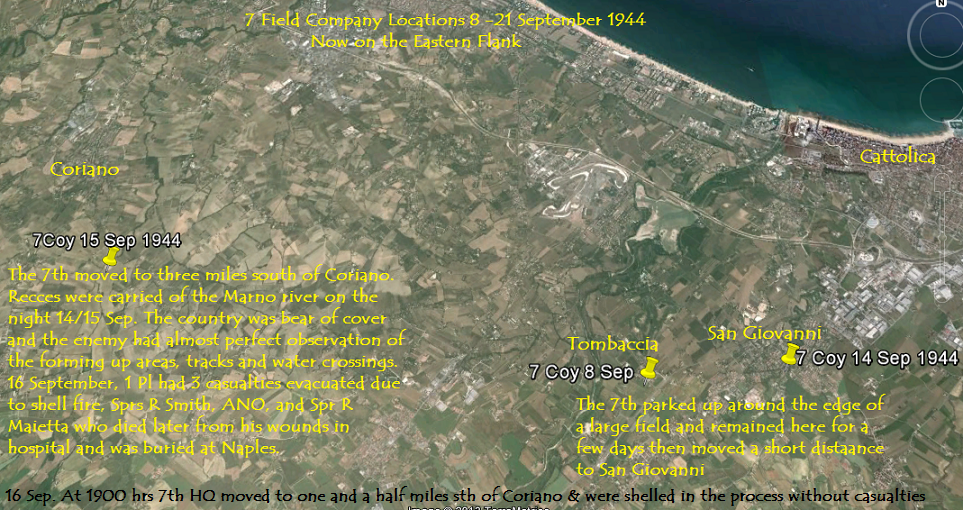
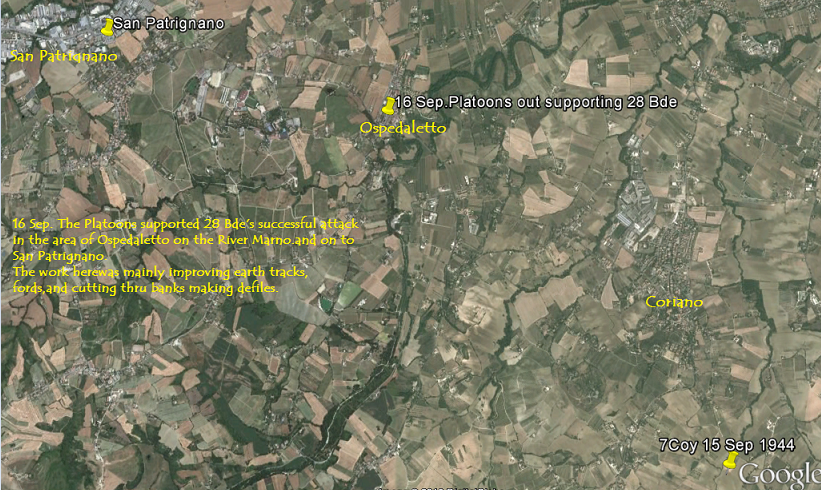
15 September. The 7th moved at 1000 hrs to a location three miles south Coriano. Recces of the Marno river were carried out during the nigh of 14/15 September. The country was bare and the enemy had almost perfect observation of the forming up areas, tracks and water crossings. It was a matter of attacking from one ridge to the next, with the attackers in full view of the enemy.
16 September. 1 Pl had three casualties evacuated due to shell fire, Sprs R Smith, ANO, and Spr R Maietta who later died of his wounds in hospital 17 November 1944. He was buried at Naples.
At 1900 hours, 7th HQ moved to within one and a half miles of Coriano under shell fire, fortunately without casualties or damage
18 September.28 Bde were now in reserve as 10 Bde led the attack towards the last river line on the Marecchia. 28 Bde had taken 130 prisoners and destroyed eight tanks including two 'Tiger' and 'Panther' tanks.
20 September. 2 Pl went ahead during the night September 20/21 in support of 2/4 Hants & 2 SLI attack across the Marechia to the ridge beyond on the lateral road Route 9 leading to Rimini one mile east from the objective Santa Gustina. The heavens opened up and the rain came cascading down halting traffic and tanks couldn't move.
21 September. Thursday. All non-essential vehicles were grounded. The Brigade took their objective and the Marecchia, a wide river had not presented the hazard expected. Work began at once improving the crossing places, roads and tracks on the approaches each side of the river. The 3rd Greek Mountain Bde trained to fight in mountains drove forward on the only piece of flat country on the whole front by the sea to capture Rimini, said to be the key to the Lombardy Plain. Coy HQ moved arriving at a location south of the Marecchia.
22 September. The Division were ordered to stand fast. The routes into the 28 Bde bridgehead were left clear for 5 Canadian Armd DIV to move up and take over from 28 Bde to launch ‘Cavalcade’ the advance into the plain (the Romago). The Platoons continued with maintenance of routes as more heavy rain fell.
8th Army had been sapped in the ‘Gothic Line’ fighting, when half of the 14,000 casualties were suffered by the infantry. 1 Armd DIV, was used to reinforce other formations. 56 DIV was reduced to two brigades, and all infantry Battalions throughout the Army were reduced from four to three rifle companies. A/T and A/A RA units were converted to infantry, and then used as reinforcements as none were forthcoming from the UK.
As rain came down in torrents the ‘Shiny 7’ continued to slog away improving routes over the river Ausa, forward to and across the Marecchia to route 9.
01 October Sunday. 4 DIV returned to V Corps and at 2030 hrs the 7th moved to a new location near a small village of LA Villa south of the Marecchia. All vehicles were bogged down in a field during the early hours of Monday. After a good breakfast, vehicles were recovered and Platoons headed for the nearest ‘casa’. Vehicles clustered around the ‘casa’ and farm buildings on hard standings. Most of the casas had their own wine press, and fat arable fields grew abundant crops of water melons. Stone steps at the side of and built into the building led to a large communal room which in some ‘casas’ had small rooms on each side. There were two or three families living in one building supplemented by a couple of Sections, and they got on well together-usually the eldest female known to the Sappers as the ‘Gaffa Senorita’ controlled the cooking for the civilians, and not least the bartering, cost of laundry etc.
10 October. Work on roads and tank routes was handed over to 565 Corps Fd Coy and the next day there was a NAAFI ration, a sure sign that something was in the wind. A period of training began including work with the Plymouth Assault ‘Bailey’ Bridge carried on a turret-less tank, mine warfare, weapon training, drill, church parades, and soccer matches were played. Booby trap courses were part of a refresher campaign.
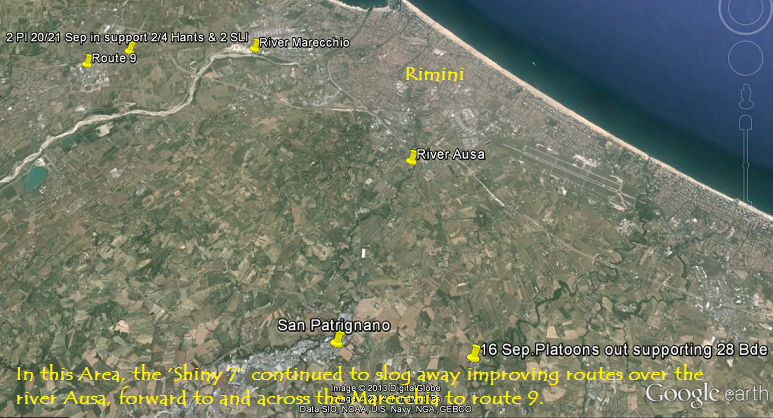
a
21 October. Saturday. 1 and 2 Pl moved to the river line with ‘59’, 2 RF of 12 Bde. A supply line was required across the ‘Savio’, which was 82’ to 150’wide and 4’ to 10’ deep with a current of 5 knots. The banks were either steep or wooded, or soft and marshy. It was a formidable obstacle. There were two bridges in Cesena one of which was still standing with the centre span blown. The enemy was still holding out here and there, approaches, bridge sites, and fords came under heavy well directed shell fire supplemented by mortars. It was not possible to build a BB over the blown span on the bridge named ‘Keatings’ as the enemy kept up a continuous stonk, but an ‘Ark Bridge’ of four Arks over a ford enabled some tanks of 142 RAC to cross into the bridgehead. Heavy rain fell during the evening and the Ark crossing was awash. 1 & 2 Pl began building an FBE trestle bridge south of the Ark but stonks slowed work down.
22 October. the work was held up by heavy shell fire causing nine casualties in 2 Pl including Cpls Horsley and Smiles- Sprs Herbert and Pattison. Flood water swept the ‘7’s incomplete FBE bridge away into the ‘Ark causeway’ in which a gap was torn near the far bank. In the afternoon flooding of the river subsided. It was possible for the 7th to fill the gap in the ‘Ark causeway’ with sand bags, and then to build and operate an assault boat ferry, taking supplies across and evacuate the wounded.
20 October. The 7th moved to a concentration area at Montiano. The conditions would be a severe test, apart from the enemy fighting as skilful as ever. Equal in numbers and supported by powerful artillery. It was easy for them to concentrate quickly at the danger point. 8th Army had received new equipment, heavier tanks, self- propelled guns and flame throwers, but they could not be used with real effect as they had been shipped without spare parts.
4 DIV’s task in the scheme of operations was to thrust forward on the right flank of V Corps. The immediate task was to capture, and clear Cesena on Route9 astride of the Savio, both the 7th and ‘59’ were in support of 12 Bde making the assault.
26 October. The enemy pulled back to the next river line the Ronco. The 7th moved forward to a large building in Forlimpopli south of the railway, and the enemy brought down stonks using SP guns on the location indicating he had excellent Ops. All units of 12 Bde were congratulated by the Army, Corps and Divisional commanders on their efforts in Cesena. The 7th apparently were too busy to record this as they filled craters, opened and maintained water points and recced the river Ronco for bridge sites on the ‘Gudrun Line’. A ford for tanks was found. As the first tank moved forward onto the nearside approach it was knocked out effectively blocking the crossing. The Loyals attached to 4 DIV and 2 DCLI crossed the river in pouring rain. Both Bns were cut off without support, and both bridgeheads were eliminated by the enemy using tanks causing a setback.
An Achilles 17 Pdr Tank Destroyer of 93 Anti Tank Regt crossing the River Savio in Cesena 24 Oct 1944
7 Coy built the approaches to this Ark Bridge and were working at this site when the photogragh was taken. The NCO on the bank is most likely from the Shiny 7th
23 October. Captain Corry recced the river line from 0200 hrs to 0630 hrs without incident. Due to the efforts of the 7th on the causeway Jeeps crossed the Savio with sorely needed supplies.
25 October. Company HQ moved into the town hall in Cesana and work was handed over to V Corps Troops RE. Platoons were literally glued in the banks of the Savio, having built FBE rafts, assisted with ‘Keatings’ Baily Bridge, and built an FBE bridge.
A Canadian Anti-Tank vehicle fires on enemy positions across the Savio River Oct 1944
Trucks hauling bridging equipment pass through Rimini October 1944
German prisoners and Canadian soldiers carry wounded in Cesena October 1944
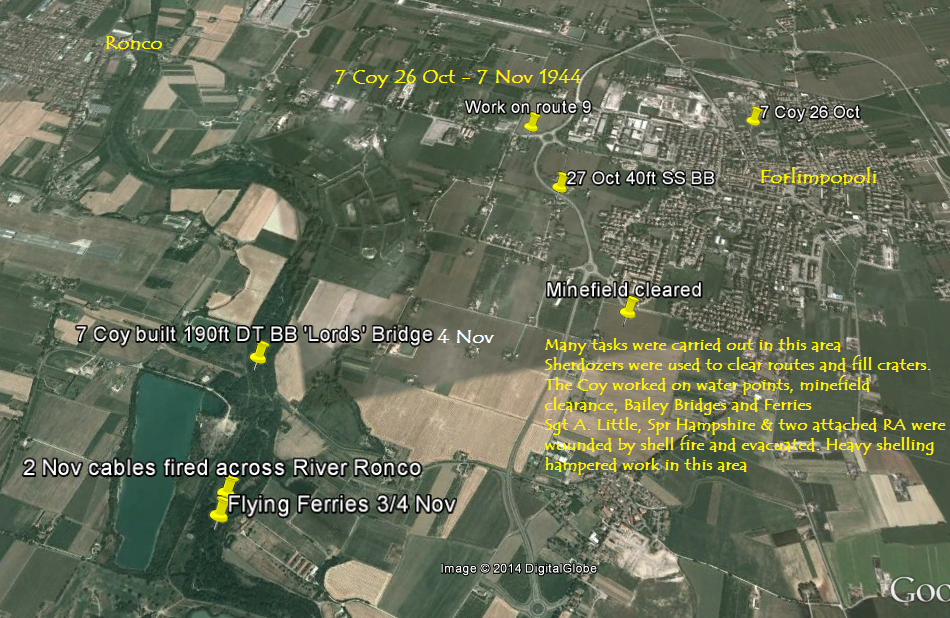
08 November. The OC left for the UK and Major S H A Johnson was posted in as the OC. In the attack on Forli airfield, Lt Barnes successfully blew down a bank with a ‘Wade’ charge to make a passage for vehicles. A ‘White’ Scout car was used to transport a Section of 2 Pl. an Ark and AVRE blew up on mines. A ‘Tiger’ tank made up for lack of excitement moving around buildings on the opposite side of the airfield. The assault party dodged out of sight taking cover screened by buildings, the cat and mouse situation continued for some time until the ‘Tiger’ veered off. The successful attack on Forli airfield was held as brilliant attack by General Alexander, showing as it did, outstanding co-operation by all arms.
09 November Thursday. Company HQ made a move to a house near Forli, and were stonked. Rain was pouring down as they moved out after a direct hit on the building. Finally, finding a billet in the pitch dark. Shrapnel from a shell killed Sgt F Clark DCM, 3 Pl, as the Platoon returned to a billet after clearing a road up to Forli. ‘Typhoons’ blasted and machine gunned German positions, HQ s and stores dumps, in cab rank style with sustained fury. The enemy retaliated heavily stonking the area. The next day Coy HQ recovered stores, cooking equipment, and bedding from the rubble of their previous billet. Lt Cummings 3 Pl successfully recced the main bridge in Forli - the gap was 120’ and the Platoon cleared booby traps in the town when two Sprs were wounded and evacuated.
The enemy was taking a severe hammering, pulling back in disarray but they were saved a much heavier defeat, as snow and heavy rain closed down visibility grounding the air attack.
"Lords Bridge" a triple storey double truss 190ft Bailey Bridge over the River Ronco near Forli.
Cpl Ralph is seen working on the far side bankseat. Photo by kind permission the Imperial War Museum
3 Platoon used the Sherdozers
Vehicles of 142nd RAC following Churchill tanks into the city
East Surreys make a surprise attack on Forli airfield without armour on the first night
12 November. The Montone recces were completed without incident - Coy HQ received a direct hit on the cookhouse, Cpl E M Pirie and Spr G Spong were killed, Lcpl Brown and Spr Bradley were wounded and evacuated. HQ then made a prudent move to 1 Pl location. 28 Bde with the 7th in support were driving NW of Forli pressing the enemy back and beyond the Montone. The Division’s task was to push the enemy back to the Lamone river line which covered Faenza on Route 9, the 8th Army’s winter objective.
13 November. Coy HQ moved billets again into Forli, reported as less noisy, and a party went to a show in Cesena.
14 November. Cpl Pirie and Spr Spong were buried next to Sgt Clark. Mine clearing, filling craters, clearing nine pylons drooped across a road and the construction of a 40’ SS BB kept the 7th busy.
At 1900 hrs Lts Cummings and Smart under command of the 2 SLI recced the Montone river approximately three quarters of a mile NW of S Martino. The right hand recce party (Lt Cummings) was ambushed and six ORs of 2 SLI were killed - the left hand recce was carried out successfully, but enemy vehicles could be heard on the far bank.
15 November. During the night 2 Pl cleared the lateral road S. Martino - Villfranca of mines, obstacles, dropped pylons and trees. The 7th continued working on roads, water points, mine and booby trap clearing.
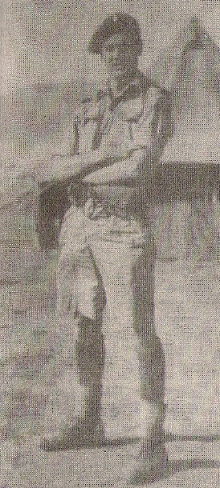
Lt Malcom Sharland
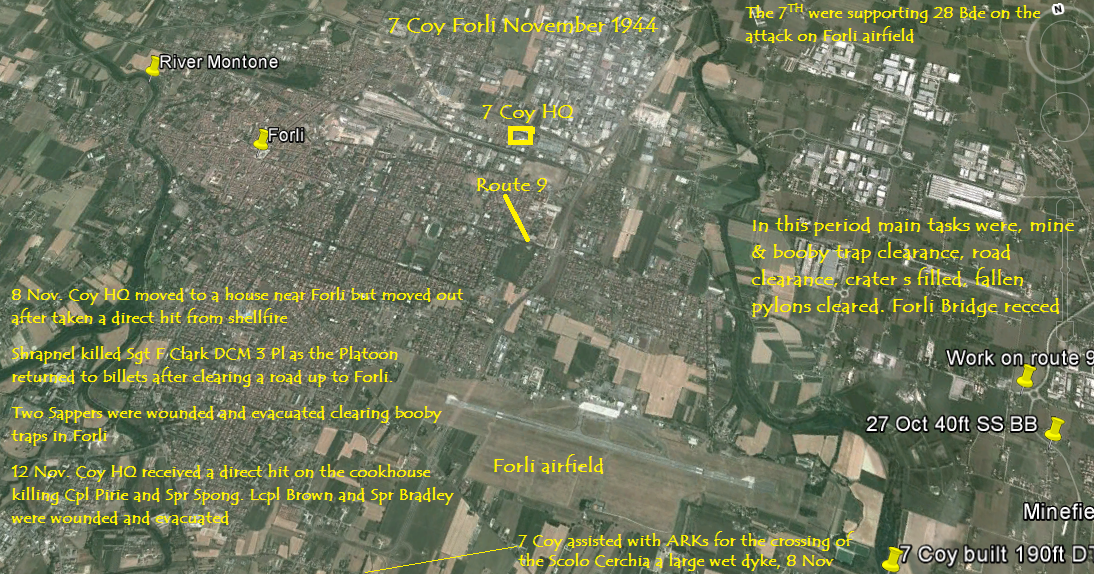
20 Nov. Platoons moved back in front of Forli between Route 9 and the railway line with the Montone flowing down the right of the railway, in support of 28 Bde who would exploit through the 10 Bde attacking towards Faenza between the railway and the river Montone. 10 bde would cross the Cosina a tributary of the Montone which flowed SW to NE at right angles across Route 9. The direction of the attack had the effect of outflanking the Montone. The 7th were busy sweeping areas and tracks up to the foremost infantry.
21 Nov. At 0200 hrs 10 Bde attack went in. By dawn it was clear that the attack was not a success as only a few Platoons of the assault Bns had secured their objectives, and were under continuous attack. These attacks were broken up by 4 DIV’S guns. The infantry made a planned withdrawal to the southern bank of the Cosina. During the morning a new plan was made by the Army, Corps and Divisional Commanders- 4 DIV would take over part of 46 DIV front on the immediate left of route 9, across the Cosina and then wheel right pivoting on the far bank of the Cosina then continuing to and consolidating on Route 9 and if possible the railway. 28 Bde moved forward and took over the 46 DIV sector, 2 Kings made a firm base by sweeping the nearside of Cosina clear of the enemy.
22 Nov. The 7th sent recce patrols forward to the Cosina, 3 Pl worked on an artificial bank seat for an Ark bridge. A Section was attached to ‘59’ assisting them to make a diversion around a large crater. One Section of 2 Pl teamed up with an assault Squadron RAC/RE. 1 Pl moved to 2 SLI & 2/4 Hants to support the attack. 2000 hrs the attack went in meeting heavy resistance from the enemy in positions along the far bank of the Cosina.
2015 hrs. 2/4 Hants suffered many casualties in their FUA from shell fire, in spite of this they pressed forward. Searchlights in the 46 DIV area gave a little light, ground conditions were poor and no tank was to follow in the tracks of another. The infantry advanced into enemy positions over flat plough land and meadows. Nothing stopped them, and by daylight both Bns were firmly on their objectives waiting for crossings to be made for tanks and A/T guns to come forward to their support.
23 Nov. Sappers of the 7th and the assault RE worked strenuously to place Arks across the Cosina. Arks and tanks bogged on the nearside. A few minutes after 0730 hrs the first crossing was open. ‘A’ Squadron crossed safely into the 2 SLI bridgehead, watched by Major-General Ward 4 DIV GOC. At 1100 hrs a second crossing was open, and although tanks bogged down as they advanced towards their objectives the enemy surrendered to 2 SLI.
1530 hrs. The second phase of the operation began as the infantry wheeled right, closing on Route 9 from Cosina Bridge, Piazzetta - Cosina Village and by nightfall all of 28 Bde objectives were securely held. Lt Hobson and Sgt Rogerson 1 Pl made a forward recce by-passed by the 2 SLI. They decided to check out a farm house, and found a wounded German on a rough bed with a wound in one leg. He could not be left and the problem of moving him was solved with a wheel barrow. A crude but effective sling tied around his neck supported his leg. They took it in turns pushing the wheel barrow to the nearest SLI HQ in a ‘Casa’. Bathed in sweat they went in and reported a wounded German prisoner in a wheel barrow. When they came out they found the wheel barrow was empty and the wounded German was fast asleep in a ditch.
3 Pl took over the maintenance of the Ark crossings under periodic stonks. One ‘white’ scout car was written off. 2 Pl with the assault Squadron RE were making fascines for AVRE’s to place in new crossing places. 1 Pl pushed on with 2 SLI & 2/4 Hants.
During the hours of darkness there was a huge flash and explosion-bearings indicated that the enemy had blown the main bridge over the river Lamone indicating that he had withdrawn his heavy equipment west of the river.
24 Nov. Friday. The 2 kings continued 28 Bde’s successful advance to Corleto. There was no opposition, but delay was caused by mines, demolitions and debris strewn about by the retreating enemy. The final objective, La Palazzina about one mile west of the Cosina and Montone rivers were captured. The 7th continued in support, 1 and 3 Pls switching tasks, 2 Pl prepared with the Assault RE for a further operation in support of 4 Recce Regt now leading the advance to the banks of the river Lamone.
25 Nov. Routes were opened north to Route 9. At one point barrels were used in a crater, a method often used by Sappers in Wellington’s time. The Divisions on the left and right of 4 DIV also closed up to the Lamone. ‘59’ took over all tasks, mechanical equipment and attached troops except the A/T RA who returned to their units to be trained as infantry.
26 Nov. at 1000 hrs the 7th left for Forli in convoy travelling south via Route 9 on to coastal Route 16, arriving at Porto Civitanova south of Ancona for tea at 1700 hrs. After a journey of 134 miles, which continued the next day to Citta S Angelo arriving at 1300 hrs. MT was spaced around a square in the town where billets were ready. the OC told the Company that they would be leaving Italy for a long awaited break, and that tools and transport would be taken over by 5 DIV.There was a big celebration that evening, and for the next three nights, tools were sharpened, store, equipment, vehicles were tested and cleaned looking the proverbial ‘Clean Bright and slightly oiled’. Surplus arms, salvage, and bedding was collected and taken to dumps. An order was given to burn all maps, and so it happens that there were no maps to hand in for that era.
01 Dec. General Alexander was promoted to Field Marshal back dated to the capture of Rome June 4th.
02 Dec. Lt Bocker was left in charge of the rear party, and the Shiny 7 left Citta S Angelo at 1700 hrs in a RASC transport for Ortona to board a train 30 to a truck. The train pulled out at 2030 hrs down the coast to Taranto where it arrived at midnight the next day. The 7th could put their kit down as they were to sleep on the train, marching off the next morning at 0800 hrs to Dowler Camp where a hot breakfast of M & V was waiting. Bivvies were issued for accommodation. Inter-Platoon competitions, and recreation was the order of the day as the 7th waited for the ship.
12 Dec. Lt Barnes and two Sections as Engineer support flew to Greece with 28 Bde less 2 SLI. The main body less the rear party embarked on ‘HMT Banfora’ sailing the next day at 1700 hrs.
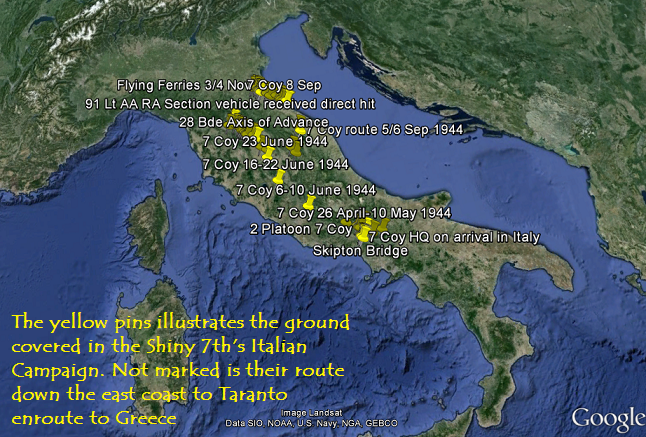
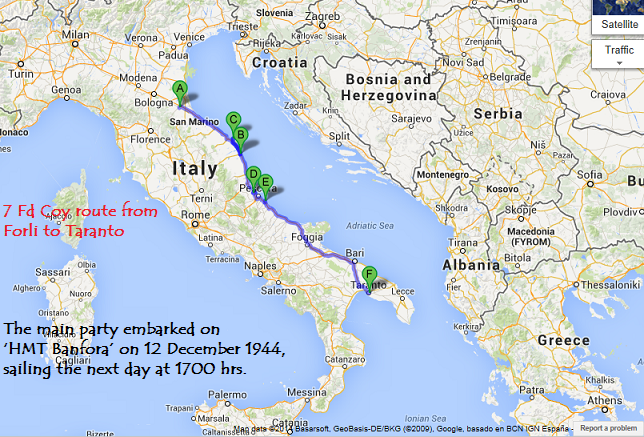
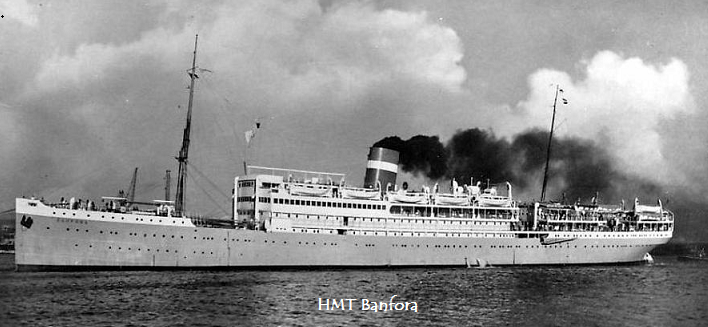
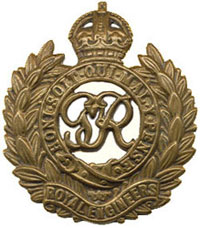
4 Division TRF
7 Field Company RE, TRF
King George VI cap badge
Forli Airfield
Above:The 7th busily moved stores and personnel in this flying ferry across the Ronco, and ferried casualties back. Working day and night continuously, 60 loads were transported into the bridgehead.
Right: 2 Platoon, 7 Coy ferry stores across the River Ronco. The men on the ropes are attached personnel
7 Field Company ferrying supplies across the River Savio 22-24 Oct 1944
Men in boat;
At the back third from left with helmet, Spr Joe Gilleard
Front, far right with helmet, Spr Gorman
German gun emplacement at Viserba on the Adriatic coast north of Rimini
Lt Sharland wrote several poems during the Italian Campaign. The following is the last poem he wrote before he was killed on the 19 July 1944. It depicts the scene in the drive forward from Rome to Arrezo, and has no title.
Peace is in the valley, where the tide
of futile war swept through but yesterday.
Swept surging through, too swift to pause and lay
Its scars upon the silent countryside.
The valley sings with the harvest; every field
O'erflowing; every orchard filled with grain,
with corn between the trees in every lane,
singing their joy, the glory of the yield.
And through the pleasant pastures, peasant hands
reap and bind, and in neat crosses lay
the golden sheaves, or resting 'neath the green.
Cool shade of orchard trees, wave happy hands
in gratitude which no words can portray,
as the transport of an army plies between.
The advance north after the Rapido Operations 1944
02 November. work started on ‘Lords Bridge’ 180’ TS, a crib pier was erected on the nearside and subsequently swept away in torrential rain causing floods. Meanwhile three A/T mines were removed from the site and 2 Pl shooting a cable across the river with a PIAT made good progress erecting a SWR cable, and flying ferry in support of 10 Bde. Major Shore-Porter became OC in place of Major Bond MC. Next day the 7th finished the flying ferry and busily moved stores and personnel across the Ronco and ferried casualties back. working day and night continuously 60 loads were transported into the bridgehead. A second ferry was built with infanteers and the attached gunners of 91 Lt AA RA worked on approaches.
04 November. it was decided to build a 190’ DT, BB at ‘Lords’ and not 180’ TS previously planned. The third storey was added by 2 Pl ‘59’(attached) using a Coles and Michigan crane. Lt Barnes assumed command of ‘Lords’. Infantry of 28 Bde laid Somerfield tracking on the approaches under supervision and at times work was held up by stonking.
O7 November. ‘Lords Bridge’ was handed over to the‘59’ to complete. 50% of the launching nose had been removed. The bridge still had to be jacked down and some decking to be completed. A recce for a new site on the far bank was carried out and the 7th were now supporting 28 Bde attacking Forli airfield. Six store trucks sent to 2 Pl across the river were unable to return due to stonking and MG fire for some hours.
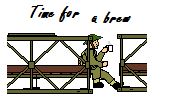
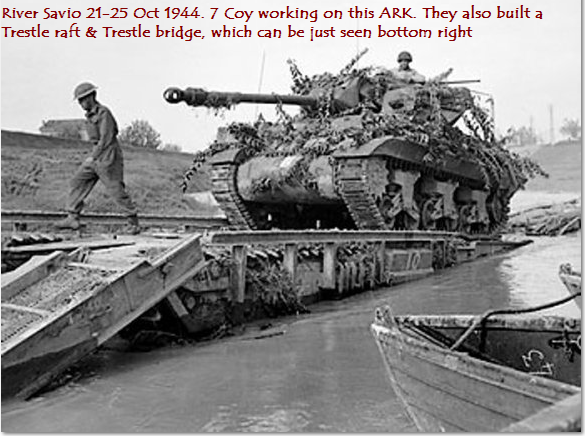
27 October. The 7th maintained Route 9, constructing a 40’ SS over a blown culvert and set up a water point. 3 Pl worked on the route with three ‘Sherdozers’.
30 October. Stonks caused inevitable casualties, Sgt A Little and Spr Hampshire 1 Pl and two ORs of the attached RA, were all wounded by shell fire and evacuated. The enemy kept up intense stonking of approaches, and FUPs. The next day a suitable site for a BB was found, and 1 Pl stood ready to bridge as soon as the 4th Recce Regt came forward to cross the Ronco.
The Shiny 7th's involvement in the Italian Campaign Part II The Gothic Line 23 June - 26 Nov 1944
MA31 White Armoured Scout car
7 Coy often used these vehicles
A short video clip of 2 platoon 7 Fd Coy ferrying stores across the river Ronco 2 Nov 1944
click the link
See short video clip at bottom of page
Photos courtesy
The IWM




